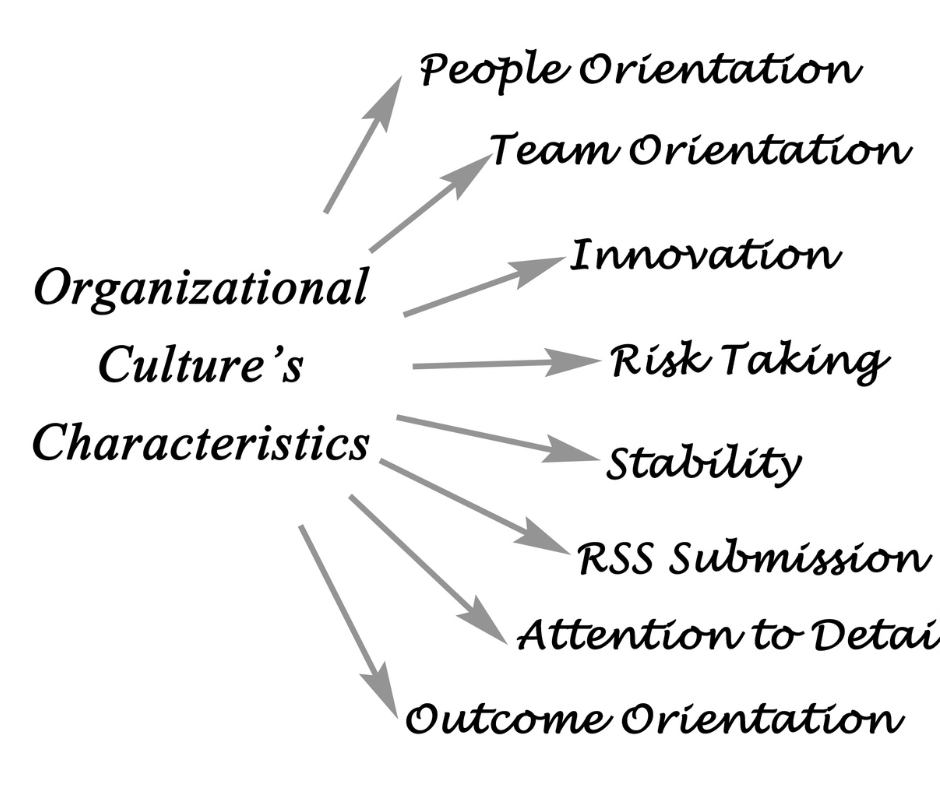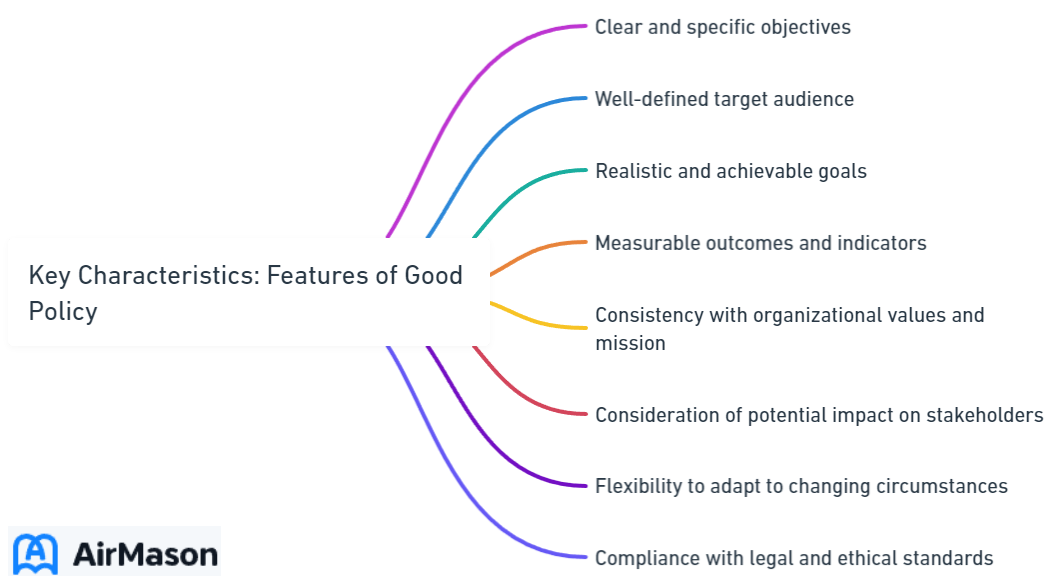
Good policy plays a crucial role in organizations, institutions, and governments as it provides a framework and guidelines for decision-making and actions. Understanding the key characteristics of good policy is essential in order to develop effective and impactful policies. These characteristics ensure that policies are well-designed, relevant, and capable of bringing about desired outcomes. Some key characteristics of good policy include clarity and specificity, relevance and purpose, consistency and coherence, flexibility and adaptability, evidence-based and informed, inclusive and participatory, and measurable and achievable. These characteristics ensure that policies are clear, align with objectives, are adaptable to changing circumstances, are based on evidence and input from stakeholders, and can be measured and monitored for effectiveness. By examining examples of policies that possess these key characteristics, we can understand how they contribute to positive social, economic, and environmental outcomes. Good policy has a significant impact on various aspects of society, such as improving public health, enhancing economic growth, and promoting social equality. Understanding the features of good policy is crucial for policymakers, organizations, and communities to develop policies that effectively address challenges and contribute to positive change.
Importance of Good Policy
Good policy is crucial for organizations and governments due to the following reasons:
- Clear Direction: Good policy provides a clear direction and sets specific objectives for achieving desired outcomes. It helps organizations and governments focus their efforts and resources on a common goal.
- Consistency: A well-crafted policy ensures consistency in decision-making and actions. It provides a framework for making choices and ensures that similar situations are treated in a similar manner.
- Efficiency: Good policy promotes efficiency by streamlining processes and eliminating unnecessary steps. It helps organizations and governments allocate resources effectively, reducing waste and maximizing productivity.
- Transparency: Policies that are transparent and easily accessible promote trust and accountability. When stakeholders can understand the rules and guidelines, they are more likely to comply and participate in achieving the desired outcomes.
- Risk Management: Effective policy considers potential risks and establishes guidelines to mitigate them. It helps organizations and governments anticipate and address challenges proactively, minimizing the negative impact of unforeseen events.
- Compliance and Legal Framework: Good policy ensures compliance with relevant laws, regulations, and ethical standards. It provides a legal framework for decision-making and helps organizations and governments avoid legal and reputational risks.
- Flexibility: While policies provide structure, they should also allow for flexibility to adapt to changing circumstances and evolving needs. Good policy is adaptable and can be revised or updated as required.
- Stakeholder Engagement: Involving stakeholders in the policy development process fosters ownership and support. It allows for diverse perspectives and ensures that policies consider the needs and interests of all relevant parties.
- Accountability: A well-defined policy holds individuals and organizations accountable for their actions. It provides a basis for evaluating performance, identifying areas for improvement, and taking corrective measures when necessary.
- Long-Term Vision: Good policy takes into account long-term goals and sustainability. It considers the broader impacts and implications of decisions, promoting responsible and forward-thinking actions.
By recognizing the importance of good policy, organizations and governments can establish effective frameworks that guide decision-making, promote efficiency, and contribute to overall success.
For more information on the key characteristics and features of good policy, you can visit the External Link.

Key Characteristics of Good Policy
Good policies are essential for effective governance, but what are the key characteristics that distinguish a good policy from a mediocre one? In this section, we will uncover the qualities that define a good policy. From clarity and specificity to relevance and purpose, consistency and coherence to flexibility and adaptability, evidence-based and informed decision-making to inclusivity and participation, and finally, measurability and achievability. Join us as we explore these essential elements that shape impactful policies.
Clarity and Specificity
When it comes to creating effective policies, clarity and specificity are imperative. It is crucial to ensure that policies are clear and well-defined to guarantee understanding and compliance. Here are some key points to consider:
- Policies should clearly state their purpose and objective, leaving no room for ambiguity. This is essential to ensure that everyone involved understands the intended outcome.
- Specificity in policies is important to provide clear guidelines and instructions. Ambiguous or general statements can lead to confusion and misinterpretation. Including specific details such as timelines, expectations, and required actions helps accurately convey the intended message.
- Clear policies help establish expectations and boundaries. When it is explicitly stated what is acceptable and what is not, individuals have a clear understanding of their obligations and the consequences of their actions.
- Specific policies contribute to consistency and fairness. When policies are clear and applied consistently, it ensures that all individuals are treated fairly and equally.
- Clarity and specificity also facilitate communication and decision-making. When policies are clearly articulated, individuals can easily seek clarification or make informed choices based on the provided guidelines.
Clarity and specificity are crucial in policy-making as they ensure understanding, compliance, consistency, and help establish clear expectations. Policies lacking clarity and specificity may lead to confusion, misunderstandings, and potentially ineffective implementation.
To avoid these pitfalls, organizations often turn to the use of a well-crafted policy and procedure template. Such templates serve as valuable tools in ensuring that policies are not only clear and specific but also easy to create and maintain, ultimately contributing to smoother operations and better communication within the organization.
Relevance and Purpose
When it comes to crafting a policy, relevance and purpose are two vital considerations. A policy must be directly applicable to the specific problem or issue it aims to address, ensuring that it maintains relevance to the context in which it will be implemented. The purpose of a policy is to provide guidance and direction, ultimately influencing behavior or decision-making.
In order to achieve relevance, policymakers must conduct thorough research and analysis to understand the current situation and identify the underlying causes of the problem. This allows them to develop a policy that specifically targets those causes and effectively addresses them. For instance, when designing environmental policies, it is essential to consider the specific ecological challenges faced by a region and tailor the policy to those circumstances.
The purpose of a policy should be clearly defined and communicated. Policymakers need to articulate the intended outcomes and goals of the policy. This helps stakeholders understand the reasons behind the policy and what it aims to achieve. When the purpose is well-established, it becomes easier to evaluate the success or failure of the policy based on its intended impact.
Relevance and purpose are critical in ensuring that policies are not arbitrary or detached from the realities they seek to address. By considering these aspects during the policy development process, policymakers can create policies that have a genuine impact and effectively address the problems at hand.
Consistency and Coherence
Consistency and coherence are crucial aspects of sound policy. They play a significant role in ensuring that policies are not only effective and reliable, but also clear. It is essential to consider several key points when it comes to consistency and coherence in policy:
- Alignment: Policies must align with the goals and objectives of the organization or governing body. This alignment is necessary to ensure a unified approach that is consistent with the overall vision and mission.
- Clarity: Policies should be easily understood, without the use of jargon or complex language that may confuse individuals. By promoting clarity, policies foster consistency in interpretation and implementation.
- Consistent Application: It is crucial to apply policies consistently across various situations and circumstances. This fairness and equality in applying guidelines and rules helps to avoid any perception of favoritism or bias.
- Integration: Policies should seamlessly integrate with other existing policies and regulations. They must not contradict or create conflicts with established rules or guidelines.
- Adherence: Consistency and coherence can only be achieved through strict adherence to policies. Regardless of position or role within the organization, all individuals involved must be aware of and abide by the established policies.
- Review and Revision: Regularly reviewing and, if necessary, revising policies is essential to maintain their consistency with changing needs and circumstances. Regular evaluation and feedback facilitate the identification and prompt resolution of any inconsistencies.
- Communication: Effective communication of policies to all stakeholders is crucial to promote understanding and compliance. Establishing clear communication channels is essential for addressing any questions or concerns related to policy consistency and coherence.
By ensuring consistency and coherence in policies, organizations can establish a strong foundation for effective decision-making, promote fairness and equality, and enhance overall organizational performance.
Flexibility and Adaptability
Flexibility and adaptability are key characteristics that are essential for effective policy-making. These attributes enable policies to respond efficiently to evolving circumstances, emerging challenges, and changing needs.
1. The flexibility of policies allows them to adjust and modify their approaches in response to new information and changing conditions. This ensures that policies remain relevant and effective over time. For instance, a policy focused on reducing carbon emissions must be flexible enough to incorporate emerging technologies or strategies.
2. Adaptability plays a crucial role in policy-making by accommodating diverse situations and stakeholders. It recognizes that different regions, communities, or industries may have unique needs and circumstances. Policies that embrace adaptability can be tailored to specific contexts while still adhering to overarching goals.
3. Policies that possess both flexibility and adaptability have a higher likelihood of achieving their intended outcomes. They can quickly respond to unforeseen challenges or take advantage of new opportunities. For example, a policy promoting renewable energy may need to adapt to technological advancements or shifts in public opinion.
4. Flexibility and adaptability require continuous monitoring and evaluation. Regularly reviewing and updating policy manual allows policymakers to assess their effectiveness and identify areas for improvement. This ongoing assessment ensures that policies remain flexible and adaptable, making necessary adjustments when needed.
A real-life illustration of the importance of flexibility and adaptability in policy-making is the response to the COVID-19 pandemic. Governments worldwide had to swiftly adapt their policies to address the rapidly changing situation. This included implementing measures such as lockdowns, travel restrictions, and social distancing guidelines to control the spread of the virus. As new information emerged and scientific understanding evolved, policymakers adjusted their strategies accordingly. The demonstrated flexibility allowed them to respond effectively to the changing needs of their populations and minimize the impact of the pandemic. This example highlights the crucial role of adaptability in policy-making, especially during times of crisis.
Evidence-based and Informed
The key characteristic of good policy that we will focus on in this text is “evidence-based and informed.” This means that policy decisions are made based on reliable data and information, ensuring that the actions and measures implemented are supported by evidence.
| Evidence-based and Informed |
|---|
| 1. Data-driven decision making |
| Policy decisions should be influenced by data collected from reliable sources. This can include research studies, surveys, and analysis of relevant statistics. By relying on evidence, policymakers can make informed choices that are grounded in facts and have a higher likelihood of success. |
| 2. Expert input and research |
| Consulting with subject matter experts and conducting research are essential components of evidence-based policy development. Experts can provide valuable insights and ensure that policy recommendations are backed by scientific knowledge and expertise. Research serves to enrich policymaking by uncovering new information and identifying effective strategies. |
| 3. Evaluation and monitoring |
| Effective policies should undergo regular evaluation and monitoring to assess their impact and make necessary adjustments. This ensures that decisions are evidence-based and that policies remain responsive and effective over time. By continuously gathering data and monitoring outcomes, policymakers can refine their approaches and ensure the best possible outcomes. |
An evidence-based and informed approach to policy-making provides a solid foundation for decision making. By relying on reliable data, expert input, and continuous evaluation, policymakers can make informed choices that are more likely to achieve desired outcomes and benefit the community at large.
Inclusive and Participatory
“Incorporating an inclusive and participatory approach is crucial when developing policies that effectively address the needs and concerns of all stakeholders. By involving a wide range of individuals and groups in the policy-making process, policymakers can ensure that diverse perspectives are considered and that the policy reflects the values and interests of the community it serves.
There are numerous benefits to adopting inclusiveness and participation in policy-making. It fosters a sense of ownership and empowerment among stakeholders as their voices and opinions are valued and heard. This, in turn, leads to increased trust in the policy and its implementation.
The inclusive and participatory nature of policy-making helps identify and address potential gaps or biases within the policy. Through engagement with different stakeholders, policymakers can gain insights into the specific needs and challenges faced by various groups, and tailor the policy to ensure fairness and equity.
This approach enhances the effectiveness and sustainability of the policy. By involving those directly affected by the policy, policymakers can tap into their expertise and local knowledge, thereby improving the policy’s practicality and feasibility. Inclusive and participatory policy-making allows for ongoing dialogue and collaboration, enabling policymakers to adapt and refine the policy over time based on feedback and changing circumstances.
Adopting an inclusive and participatory approach in policy-making is essential for creating responsive, equitable, and effective policies. By engaging with a diverse range of stakeholders and valuing their input, policymakers can ensure that the policy reflects the needs and aspirations of the community it serves, leading to better outcomes for all.
Pro-tip: To ensure inclusive and participatory policy-making, policymakers should establish clear mechanisms for engagement, such as open forums, public consultations, and partnerships with community organizations. It is also important to provide accessible and transparent information about the policy process, ensuring that everyone has the opportunity to contribute and be heard.”
Measurable and Achievable
When it comes to creating effective policies, it is crucial to ensure that they are both measurable and achievable. Here are some essential key points to consider:
- Precise goals: Policies should have specific and clearly defined objectives that can be measured. This allows for progress to be tracked and evaluated.
- Quantifiable targets: Set specific targets or indicators that can be used to measure the success or effectiveness of the policy. This could include numerical targets, percentages, or other quantitative measures.
- Realistic timelines: Policies should have realistic timelines for implementation and achieving the desired outcomes. Consider factors such as available resources, capacity, and potential barriers that may impact the achievability of the goals.
- Accountability: Identify the responsible parties or stakeholders who will be accountable for implementing and achieving the policy’s goals. This ensures that clear ownership is established, and progress can be monitored.
- Monitoring and evaluation: Put in place mechanisms to regularly monitor and evaluate progress towards the policy’s goals. This could involve data collection, performance indicators, and reporting systems to measure and assess outcomes.
- Adaptability: Policies should be flexible and adaptable to changing circumstances. As new information or challenges arise, policies may need to be adjusted to ensure they remain achievable and relevant.
- Engagement and participation: Involve relevant stakeholders and promote inclusivity in the policy development and implementation process. This helps to ensure that diverse perspectives are considered and increases the likelihood of achieving measurable and achievable outcomes.
By making policies both measurable and achievable, organizations can effectively track progress, hold accountable parties responsible, and make informed decisions based on the outcomes. It also helps to build trust, transparency, and confidence in the policy-making process.
For instance, when looking to implement these principles in your organization, consider leveraging the Menards policy and procedure template. This comprehensive resource can guide you in crafting policies that are not only measurable and achievable but also align with industry best practices, setting your organization on a path toward success.

Examples of Policies with Key Characteristics
Here are some examples of policies that exhibit key characteristics of a good policy:
- Employee Code of Conduct: A policy that outlines the expected behavior, ethics, and responsibilities of employees within an organization. It promotes a positive work culture, sets clear expectations, and helps maintain a professional environment.
- Data Security Policy: This policy establishes guidelines and procedures for protecting sensitive data and information within an organization. It includes measures such as data encryption, access controls, and regular backups to ensure the confidentiality and integrity of data.
- Diversity and Inclusion Policy: A policy that promotes diversity, equity, and inclusion within an organization. It outlines strategies for creating a diverse workforce, fostering an inclusive workplace culture, and preventing discrimination or harassment based on factors such as race, gender, or disability.
- Environmental Sustainability Policy: This policy demonstrates an organization’s commitment to reducing its environmental impact. It may include initiatives such as energy conservation, waste reduction, and the use of eco-friendly practices to promote sustainability and responsible business operations.
- Workplace Safety Policy: A policy that prioritizes the health and safety of employees. It outlines safety procedures, protocols, and guidelines to prevent accidents, injuries, and occupational hazards in the workplace.
- Remote Work Policy: With the rise of remote work, this policy establishes guidelines, expectations, and procedures for employees working remotely. It addresses issues such as work hours, communication, data security, and equipment requirements to ensure productivity and a healthy work-life balance.
- Performance Evaluation Policy: This policy outlines the process and criteria for evaluating employee performance. It ensures fairness, transparency, and consistency in performance assessments, providing employees with clear expectations and opportunities for growth and development.
- Social Media Policy: A policy that governs the use of social media by employees on behalf of the organization. It sets guidelines for appropriate online behavior, protects the organization’s reputation, and ensures compliance with legal and ethical standards.
- Conflict of Interest Policy: This policy addresses situations where an individual’s personal interests may conflict with their professional obligations. It provides guidelines for identifying and managing conflicts of interest to maintain integrity, transparency, and fair decision-making within the organization.
- Customer Service Policy: A policy that outlines the organization’s approach to providing high-quality customer service. It establishes standards for responsiveness, professionalism, and customer satisfaction, ensuring consistent and positive interactions with customers.
These examples illustrate policies that possess key characteristics of being well-defined, clear, relevant, and aligned with the organization’s values and goals.

The Impact of Good Policy
Good policy has a significant impact on various aspects of society and governance. Here are some key ways in which good policy can make a positive difference:
- Addressing Problems: Good policy is designed to address specific problems or challenges within a society. It identifies the root causes of issues and formulates effective solutions to mitigate or resolve them.
- Promoting Equality: A well-crafted policy promotes equality by ensuring fair treatment, opportunities, and access to resources for all individuals, regardless of their background or circumstances. It helps reduce disparities and create a more inclusive society.
- Enhancing Efficiency: Good policy aims to optimize the allocation of resources and maximize efficiency. It streamlines processes, reduces bureaucratic hurdles, and eliminates unnecessary barriers, leading to more effective and streamlined operations.
- Encouraging Innovation: Policy that fosters an environment conducive to innovation and creativity can drive technological advancements, economic growth, and social progress. It encourages research, development, and the implementation of new ideas and solutions.
- Ensuring Accountability: Good policy establishes clear guidelines, standards, and mechanisms for accountability. It holds individuals, organizations, and institutions responsible for their actions, promotes transparency, and helps prevent corruption and misuse of power.
- Protecting Rights and Liberties: A fundamental aspect of good policy is the protection of human rights, civil liberties, and individual freedoms. It ensures that laws and regulations respect and uphold the rights of individuals, fostering a just and democratic society.
- Safeguarding the Environment: Policy that prioritizes environmental protection and sustainability helps preserve natural resources, mitigate climate change, and ensure the well-being of current and future generations. It promotes responsible practices and encourages the transition to a greener economy.
- Promoting Social Welfare: Good policy focuses on the well-being of society as a whole. It addresses social issues, such as poverty, healthcare, education, and social security, aiming to improve the quality of life for all members of the community.
- Strengthening Governance: Effective policy strengthens governance structures and institutions. It promotes transparency, accountability, and participatory decision-making processes, enhancing the overall effectiveness and legitimacy of the governing system.
- Adapting to Change: Good policy is flexible and responsive to evolving societal needs and changing circumstances. It allows for adjustments, innovations, and improvements over time, ensuring its relevance and effectiveness in a dynamic world.
By considering these impacts, policymakers can strive to develop and implement good policies that effectively address societal challenges and contribute to the well-being and progress of communities.
Frequently Asked Questions
1. What are the key characteristics of a good policy?
A good policy should be easy to use, providing step-by-step processes that can be easily understood by new employees. It should also be written in a simple and concise manner.
2. Should policies be changed frequently?
No, policies should not be changed frequently as they need to serve as reliable guides for actions. Stability in policies is important to maintain consistency and clarity.
3. How should a procurement manual be developed?
A procurement manual should be tailored to the department’s needs and organization. It should include the necessary requirements outlined in the department’s purchasing authority approval document and follow existing department requirements.
4. Why should policies focus on achieving desired outcomes rather than specific methods?
Policies should focus on achieving desired outcomes because the specific methods may change over time. By focusing on outcomes, policies can remain relevant and adaptable to present situations.
5. What should policies in an organization consider?
Policies in an organization should be inclusive and consider the impact on different groups affected by the policy. They should also reflect the true intentions and beliefs of the company.
6. How should procedures be written in a procurement manual?
Procedures in a procurement manual should be written at a level of detail appropriate for the intended users. They should provide step-by-step instructions in a natural sequence of events, making them easy to follow.
